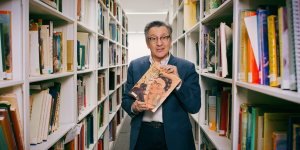I n a town known for torrid affairs, frequent heartbreak and dramatic divorces, the 50-year marriage of Joanne Woodward and Paul Newman stands as Hollywood legend. Partners in work, in love and in life until his death in 2008, their romance was famously renowned for its depth, sincerity – and intensity. The duo even had a bed in their Beverly Hills home appropriately called the “Fuck Hut” – one of many items included in A Life & Legacy: The Joanne Woodward & Paul Newman Collection, a collection of more than 300 objects from the couple’s lives selling across three auctions this June.
Their passion remained well-known in the town where they made their careers, even once they settled down in Connecticut during their later years; actor Ansel Elgort once told Town and Country how his driver recounted chauffeuring Newman and Woodward around as they made out in the back seat.
Of course, there was plenty of Hollywood drama at the start of their relationship. When they met in 1953 as understudies in the Broadway play Picnic, Newman was married with three children, while Woodward was dating the likes of Gore Vidal and Marlon Brando. Still, the attraction between them bubbled as they built their friendship. In 1957, the pair co-starred in the film The Long, Hot Summer; by the time it landed in theaters in 1958, they were married.
“Joanne gave birth to a sexual creature. I’m simply a creature of her invention,” Newman wrote in his posthumously published memoir, based in part on interviews he conducted with friend and screenwriter Stewart Stern. (The transcripts were believed lost until they were discovered in a cabinet in the couple’s house; they were published in 2022, in accordance with a line in Newman’s will that allowed his children to put out his biography.)
The World of Joanne Woodward and Paul Newman
-
 Auctions and ExhibitionsThe Art Benjamin Doller Can’t Stop Thinking About Is Back on Madison
Auctions and ExhibitionsThe Art Benjamin Doller Can’t Stop Thinking About Is Back on Madison -
 Swinging on a Star: The Private Collection of Kathryn & Bing CrosbySwinging on a Star: Inside Bing & Kathryn Crosby’s Never-Before-Seen Private Art Collection
Swinging on a Star: The Private Collection of Kathryn & Bing CrosbySwinging on a Star: Inside Bing & Kathryn Crosby’s Never-Before-Seen Private Art Collection -
 Expert VoicesSix Judaica Treasures that Reveal a Vanished World
Expert VoicesSix Judaica Treasures that Reveal a Vanished World
“There was a glue that held us together then, and through the rest of our life together. And that glue was this: anything seemed possible. The good, the bad, and the wonderful.”
Woodward earned an Academy Award for Best Actress the same year they were wed, and as the couple reached their 30s, their career arcs intersected and Newman’s star rose meteorically. They had three daughters – Nell, Melissa and Clea – between 1959 and 1965, a span of time in which she appeared in seven films, including an adaptation of William Faulkner’s novel The Sound and the Fury, and he in thirteen, including ones like The Hustler and Hud that would launch him into immortality.
Their collaborations never abated. Woodward starred in Newman’s directorial debut, 1968’s Rachel, Rachel – and earned an Oscar nomination for it. The couple continued to work together professionally for six straight decades. They shared plenty else, of course, such as a passion for civil rights and a zeal for liberal politics – letters and mementos from Presidents Clinton and Carter are plentiful among their collection, and, wryly, a framed copy of Nixon’s enemies list with Newman’s name on it.
One part of their life they didn’t share an enthusiasm for, however: auto racing. Newman was bitten hard by the racing bug in his 40s – ironically, while working on a film about a race car driver in which Woodward played his frustrated wife – and went on to drive for decades, competing in the 24 Hours of Le Mans and many other races, even racking up his fair share of podiums. One hundred artifacts from his racing career are offered in RM Sotheby’s auction High Speed: Paul Newman’s Racing Legacy. Woodward, for her part, made her feelings clear with the gift of a Rolex inscribed with the words “Drive Very Slowly.” That Rolex – a ref. 116519, included in the Important Watches auction on 9 June – was one of several Daytonas owned by Newman that cemented his legacy in horology and established the model as one of the most coveted watches of all time.
Their philanthropy was legendary; The Economist wrote in his obituary that Newman was “the most generous individual, relative to his income, in the 20th Century history of the United States.” As Newman said in his memoir: “The easiest thing I can do, frankly, is to give away money.”
And while their 50-year marriage was long a topic of public scrutiny – in a 1998 interview with Larry King, Newman attributed their longevity to a mix of “lust and respect and patience and determination” – it’s impossible to deny the purity of love and spirit that held them together through it all.
“What is finally left is, if you can make somebody laugh,” Woodward once told Today. “And he sure does keep me laughing.”
Banner: Paul Newman photographs Joanne Woodward in their Greenwich Village apartment, circa 1961. (Photo by A Louis Goldman / Photo Researchers History / Getty Images)






























